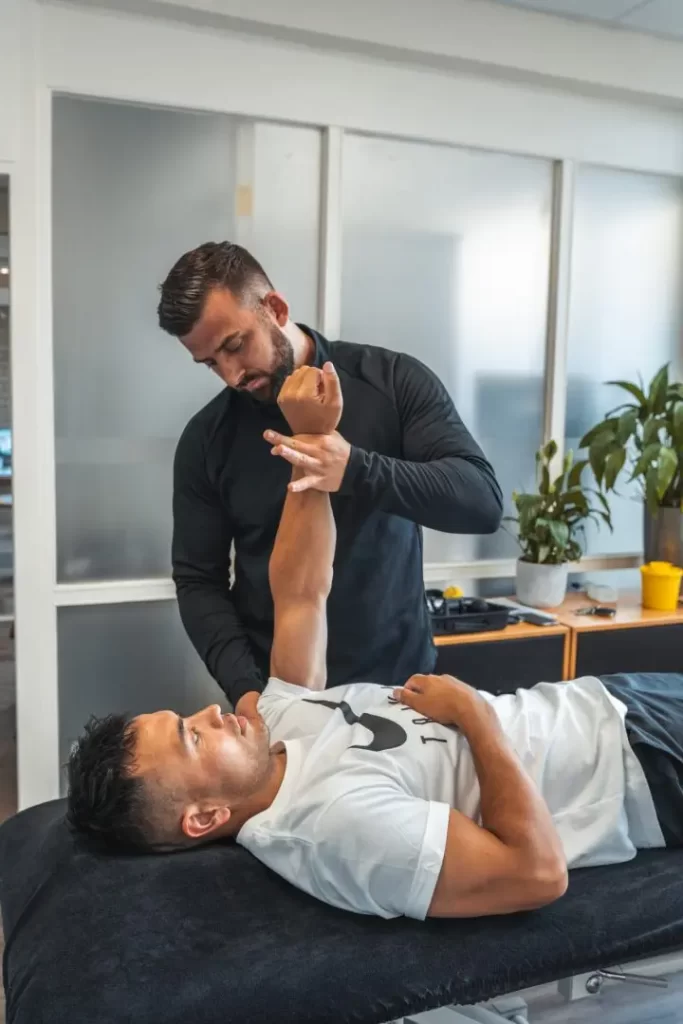Patella femoral pain syndrome
Patella femoral pain syndrome is a collective term for various complaints at the front of the knee, around the patella, or kneecap. The pain is at the front of the knee and is triggered by activities such as climbing stairs, cycling or sitting for longer periods with a flexed knee (driving a car or sitting at a desk). The symptoms often arise gradually. Patella femoral pain syndrome is more common in young women at puberty. The reason for this is still unclear but it probably has to do with hormonal changes in the body along with overloading of the knee. That is, the load on the knee has been (temporarily) greater than its load capacity. Some examples include the start of the season, being untrained, but also, for example, due to illness or simply an extended holiday. The result is sensitivity of the knee. Previous injuries to the knee also often play a role in the development of patella femoral complaints. The complaints are often intermittent. Pain-free periods alternate with provoked complaints. Often the complaints are on one side. In some cases also on both sides. However, one side is then often more painful than the other knee.
Patellofemoral pain syndrome is actually an umbrella term for pains to the knee around the kneecap. These symptoms are common in young women, which is why this condition is sometimes called 'the girl's knee'. Patella is the Latin word for kneecap. The kneecap is a disc shaped like a point made of bone. Around the kneecap are many muscles and tendons that are responsible for keeping the kneecap in place. Pinpointing a precise cause in patellofemoral pain syndrome is difficult. Often, patellofemoral pain syndrome involves weakening of the front leg muscles, also known as the quadriceps.
Complaints and symptoms
If you suffer from patellofemoral pain syndrome, it can cause various symptoms. There is often pain behind or around the kneecap. These pains occur particularly during, for example, climbing stairs, squatting but also squat exercises. Besides these pains, the feeling of instability or stiffness can also be experienced. These complaints are particularly common in young adults and often seen in girls.
Diagnosis of patellar femoral pain syndrome
The diagnosis is often made based on the information from the questionnaire, current symptoms and additional physical examination. Imaging studies such as an X-ray or MRI are not necessary and do not add anything. Various risk factors that could potentially perpetuate the symptoms are also identified. Risk factors in patellar femoral pain syndrome are:
- Reduced strength of the hip muscles
- Abnormal position of the knee
- Reduced strength of the thigh muscles
- Reduced general fitness
- Previous knee injury
Treatment of patellar femoral pain syndrome
Successful rehabilitation consists of several stages and steps. Good strength, stability and control of the knee is necessary to safely return to your daily activities and sports. Exercise therapy is most effective in the treatment of patella femoral complaints. There needs to be the right balance between adequate rest, adjustments in daily activities and training. Often, structural improvement is noticeable within 12 weeks. In a few cases, taping the kneecap will help. This is mainly a short-term effect. During the first phase of treatment, it is not recommended to continue exercising. Some pain may even be felt during exercise but it should also subside again at rest. An average pain score of 3 on a scale of 0-10 is acceptable. However, the pain should not increase from day to day. So if you have more pain during the day as a result of the treatments, a step back should be taken. Over time when the leg gets stronger, picking up your sport again is possible. In the meantime, there is more of a build-up in strength and function of the muscles around the knee. The final phase focuses particularly on maximum strength, jumping power and explosiveness. This is all needed to quickly change direction within your sport. Competitive fitness is also worked towards so that you can continue to perform under fatigue. The quality of movement must remain good under these conditions.
Anatomy and function of the knee joint
A joint is a place in the body where two bone parts come together. In the knee, this is the femur(upper leg) and the tibia(lower leg). The patella(kneecap) also forms a joint with the femur. Between these bone parts is cartilage which has a very smooth surface so that it can move smoothly. To properly control the knee joint, there are different types of ligaments in and around the knee. On the inside and outside are the collateral ligaments. Between the femur and tibia is the inner and outer meniscus this acts as a shock absorber between these two bone parts. In the knee there is the anterior and posterior cruciate ligament. The anterior cruciate ligament provides passive stability. Tyres, bones, capsules and the position of joints provide passive stability you have no control over. Active stability is controlled by muscles and tendons. So you do have control over this. Active and passive stability together determine how stable a joint is.
Making an appointment at FysioFitaal
We work from multiple locations in Tilburg, always close by for professional and accessible physiotherapy. Fill in the contact form and we will contact you soon. Together, we will work on your recovery!

